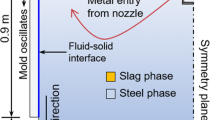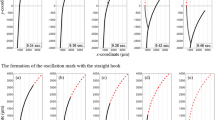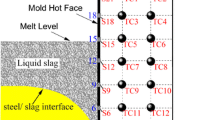Abstract
Traditional understanding on the complex multiphysics phenomenon of the meniscus in the oscillating mold for continuously cast steel, including oscillation-mark formation and liquid-slag consumption, has never considered the shape influence of the flux channel between the mold wall and the solidifying shell surface. Based on the reciprocating oscillation of mold, this study was carried out to calculate theoretically the periodic pressure and the liquid-slag layer thickness in the flux channel for the upper and the lower meniscus that possess different shapes in combination with a transient equilibrium profile of the flux channel as well as the sinusoidal and the nonsinusoidal oscillation modes of mold. The effect of flux channel shape on the multiphysics phenomenon in the meniscus was determined by the physical oscillation simulation by using an experimental cold model mold. The results show that the shape difference between the upper and the lower meniscus leads to the opposite direction of pressure in the flux channel. The pressure in the opposite direction plays a respective role in oscillation-mark formation and liquid-slag consumption in an oscillation cycle of mold, and thus, it makes a new mechanism for explaining the multiphysics phenomenon in the meniscus. The oscillation mark is initially formed by the rapid increase of positive channel pressure in the upper meniscus, and most of the liquid slag is infiltrated into the flux channel by the negative channel pressure in the lower meniscus from the end of a positive strip time to the beginning of the next positive strip time, including the negative strip time in between. Furthermore, the physical characteristics of the lubrication behavior in the meniscus are summarized, including liquid-slag infiltration, solidifying shell deformation, and the thickness change of the liquid-slag layer.
















Similar content being viewed by others
References
F. Neumann: Ironmaker Steelmaker, 2002, vol. 29, pp. 358-74.
R. Bommaraju: ISS Steelmaking Conf. Proc., 1991, pp. 131–46.
R. Taylor and K.C. Mills: Ironmaker Steelmaker, 1988, vol. 15, pp. 187-94.
J.W. Cho, T. Emi, H. Shibata, and M. Suzuki: ISIJ Int., 1998, vol. 38, pp. 834-42.
A. Yamauchi: Ph.D. Dissertation, KTH, Stockholm, 2001.
Y. Meng and B.G. Thomas: Metall. Mater. Trans. B, 2003, vol. 34B, pp. 685-705.
Y. Meng and B.G. Thomas: Metall. Mater. Trans. B, 2003, vol. 34B, pp. 707-25.
Y. Meng and B.G. Thomas: ISIJ Int., 2006, vol. 46, pp. 660-9.
A. Jonayat and B.G. Thomas: Metall. Mater. Trans. B, 2014, vol. 45B, pp. 1842-64.
P.E. Ramirez Lopez, U. Sjöström, T. Jonsson, P.D. Lee, K.C. Mills, M. Petäjäjärvi, and J. Pirinen: Mater. Sci. Eng., 2012, vol. 33, pp. 1-10.
P.E. Ramirez Lopez, K.C. Mills, P.D. Lee, and B. Santillana: Metall. Mater. Trans. B, 2012, vol. 43B, pp. 109-22.
A. Badri, T.T. Natarajan, C.C. Snyder, K.D. Powers, F.J. Mannion, and A.W. Cramb: Metall. Mater. Trans. B, 2005, vol. 36B, pp. 355-71.
A. Badri, T.T. Natarajan, C.C. Snyder, K.D. Powers, F.J. Mannion, M. Byrne, and A.W. Cramb: Metall. Mater. Trans. B, 2005, vol. 36B, pp. 373-83.
J. Sengupta and B.G. Thomas: JOM, 2006, vol. 58, pp. 16–8.
H.J. Shin, S.H. Kim, B.G. Thomas, G.G. Lee, J.M. Park, and J. Sengupta: ISIJ Int., 2006, vol. 46, pp. 1635-44.
K. Okazawa, T. Kajitani, W. Yamada, and H. Yamamura: ISIJ Int., 2006, vol. 46, pp. 226-33.
K. Okazawa, T. Kajitani, W. Yamada, and H. Yamamura: ISIJ Int., 2006, vol. 46, pp. 234-40.
T. Kajitani, K. Okazawa, W. Yamada, and H. Yamamura: ISIJ Int., 2006, vol. 46, pp. 250-6.
T. Kajitani, K. Okazawa, W. Yamada, and H. Yamamura: ISIJ Int., 2006, vol. 46, pp. 1432-41.
M. Hanao and M. Kawamoto: ISIJ Int., 2008, vol. 48, pp. 180-5.
A. Yamauchi, T. Emi, and S. Seetharaman: ISIJ Int., 2002, vol. 42, pp. 1084-93.
X.N. Meng and M.Y. Zhu: ISIJ Int., 2009, vol. 49, pp. 1356-61.
X.N. Meng and M.Y. Zhu: J. Central South University, 2013, vol. 20, pp. 318-25.
X.N. Meng, W.L. Wang, and M.Y. Zhu: Chin. J. Nonferr. Metal., 2012, vol. 22, pp. 2238-45.
X.N. Meng, W.L. Wang, and M.Y. Zhu: J. Univ. Sci. Technol. Beijing, 2012, vol. 34, pp. 1416-20.
X.N. Meng, M.Y. Zhu, and N.L. Cheng: Acta Metall. Sin., 2007, vol. 43, pp. 839-46.
X.N. Meng and M.Y. Zhu: Ironmaker Steelmaker, 2009, vol. 36, pp. 300-10.
X.N. Meng and M.Y. Zhu: Can. Metall. Q., 2011, vol. 50, pp. 45-53.
J. Yang, X.N. Meng, and M.Y. Zhu: Steel Res. Int., 2014, vol. 85, pp. 710-7.
O.D. Kwon, J. Choi, I.R. Lee, J.W. Kom, K.H. Moon, and Y.K. Shin: ISS Steelmaking Conf. Proc., 1991, pp. 561–68.
M. Suzuki, S. Miyahara, T. Kitagawa, S. Uchida, T. Mori, and K. Okimoto: Tetsu-to-Hagané, 1992, vol. 78, no. 1, pp. 113-20.
J.M. Zhang, L. Zhang, X.H. Wang, and L.F. Wang: Acta Metall. Sin., 2003, vol. 39, pp. 1285-90.
J.J. Bikerman: Physical Surfaces, Academic Press, Atlanta, GA, 1970, pp. 11-2.
Y. Chung and A.W. Cramb: Metall. Mater. Trans. B, 2000, vol. 31B, pp. 957-71.
S.Z. Wen and P. Huang: Principles of Tribology, Tsinghua University Press, Beijing, 2008.
E. Takeuchi and J.K. Brimaconbe: Metall. Trans. B, 1984, vol. 15B, pp. 493-509.
A.W. Cramb and I. Jimbo: Ironmaker Steelmaker, 1989, vol. 16, pp. 43-55.
J. Lee and K. Morita: ISIJ Int., 2002, vol. 42, pp. 588-94.
K.C. Mills and Y.C. Su: Int. Mater. Rev., 2006, vol. 51, pp. 329-51.
Acknowledgments
The authors are grateful for the financial support of Fundamental Research Funds for the Central Universities of China (N140205002) and the National Natural Science Foundation of China (51004031).
Author information
Authors and Affiliations
Corresponding author
Additional information
Manuscript submitted March 23, 2016.
Appendix
Appendix
An iteration method is used for calculating the thickness variation of the liquid-slag layer in the process of reciprocating oscillation of mold. During the iterative process, the liquid film thickness is computed at each time step by combining the dynamic channel pressure and the static pressure of molten steel. The calculation starts by setting the initial oscillation velocity, v 0, which corresponds with the oscillation moments A and B in Figure 5 for two oscillation modes, respectively. The position at 7 mm below the steel free surface is chosen as the initial flux thickness, h 0, as shown in Figure 3. The flux channel pressure and total pressure are then calculated with Eqs. [10] and [11]. Based on the Newton’s Second Law of Motion, the horizontal acceleration of the solidified shell a i is obtained by a resultant force between the total channel pressure and the static pressure of molten steel:
where P s is the static pressure of molten steel and M is the mass of the solidified shell of 64,000 kg × m−1.[17]
Then, the displacement distance of solidified shell, h i , is calculated with Eqs. [A2] and [A3] at this time step:
where u i is the horizontal velocity of the solidified shell and its initial value, u 0, is set to zero.
The sum of h 0 and h i is defined as the new thickness of liquid film, h i+1, which is used as an initial condition for flux channel pressure coupled with the oscillation velocity at the next time step:
The flux channel pressure equations are solved at each time step based on the thickness of liquid film evaluated at the previous step. Therefore, the dynamic pressure generated in the flux channel is a necessary condition for the thickness of the liquid-slag layer, which in turn changes the magnitude of channel pressure. Generally, the periodical variation of liquid film thickness has a certain time lag in relation to the mold oscillation. Figure 17 gives a flow chart of the whole procedure.
Rights and permissions
About this article
Cite this article
Yang, J., Meng, X., Wang, N. et al. Oscillation-Mark Formation and Liquid-Slag Consumption in Continuous Casting Mold. Metall Mater Trans B 48, 1230–1247 (2017). https://doi.org/10.1007/s11663-016-0880-x
Received:
Published:
Issue Date:
DOI: https://doi.org/10.1007/s11663-016-0880-x





